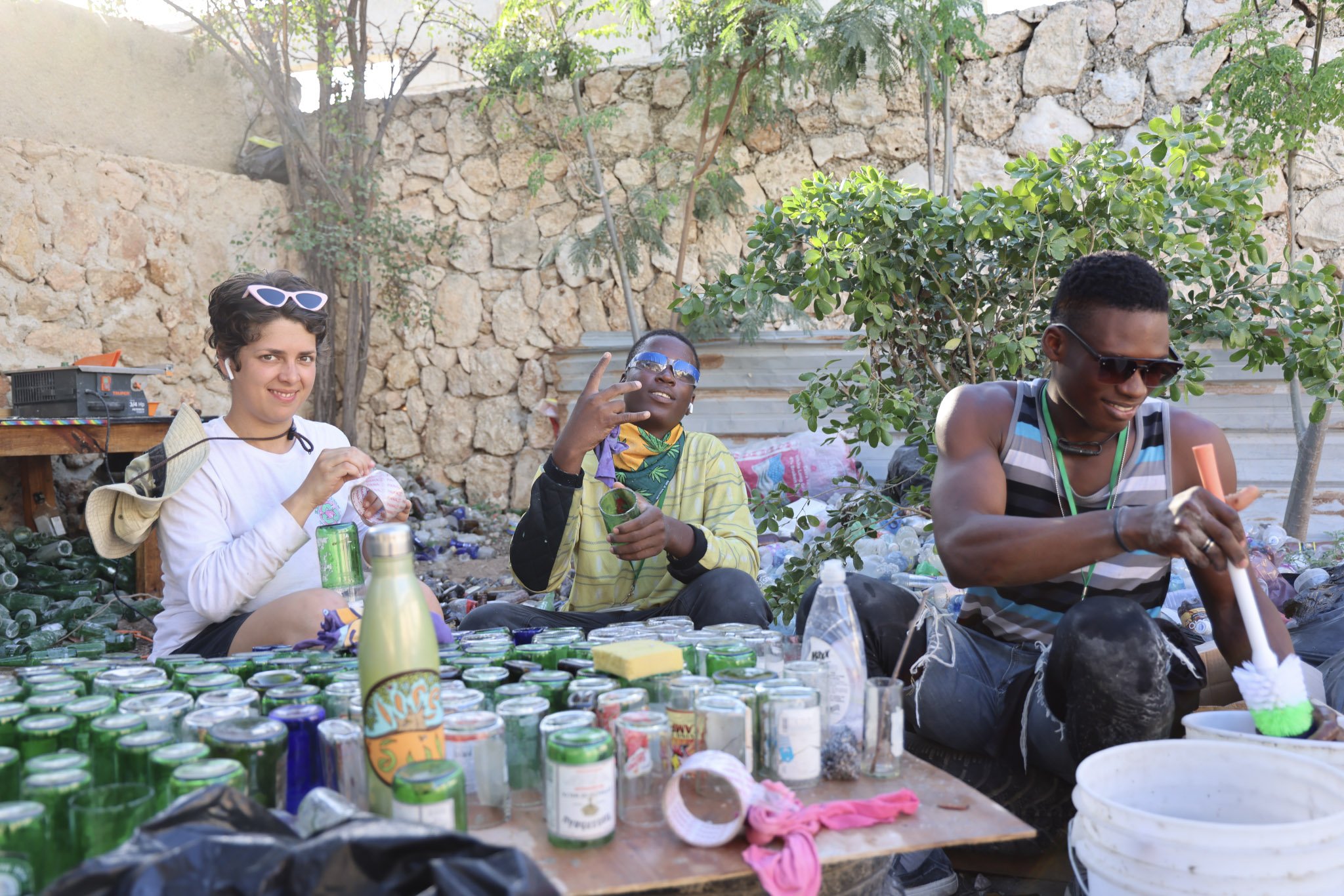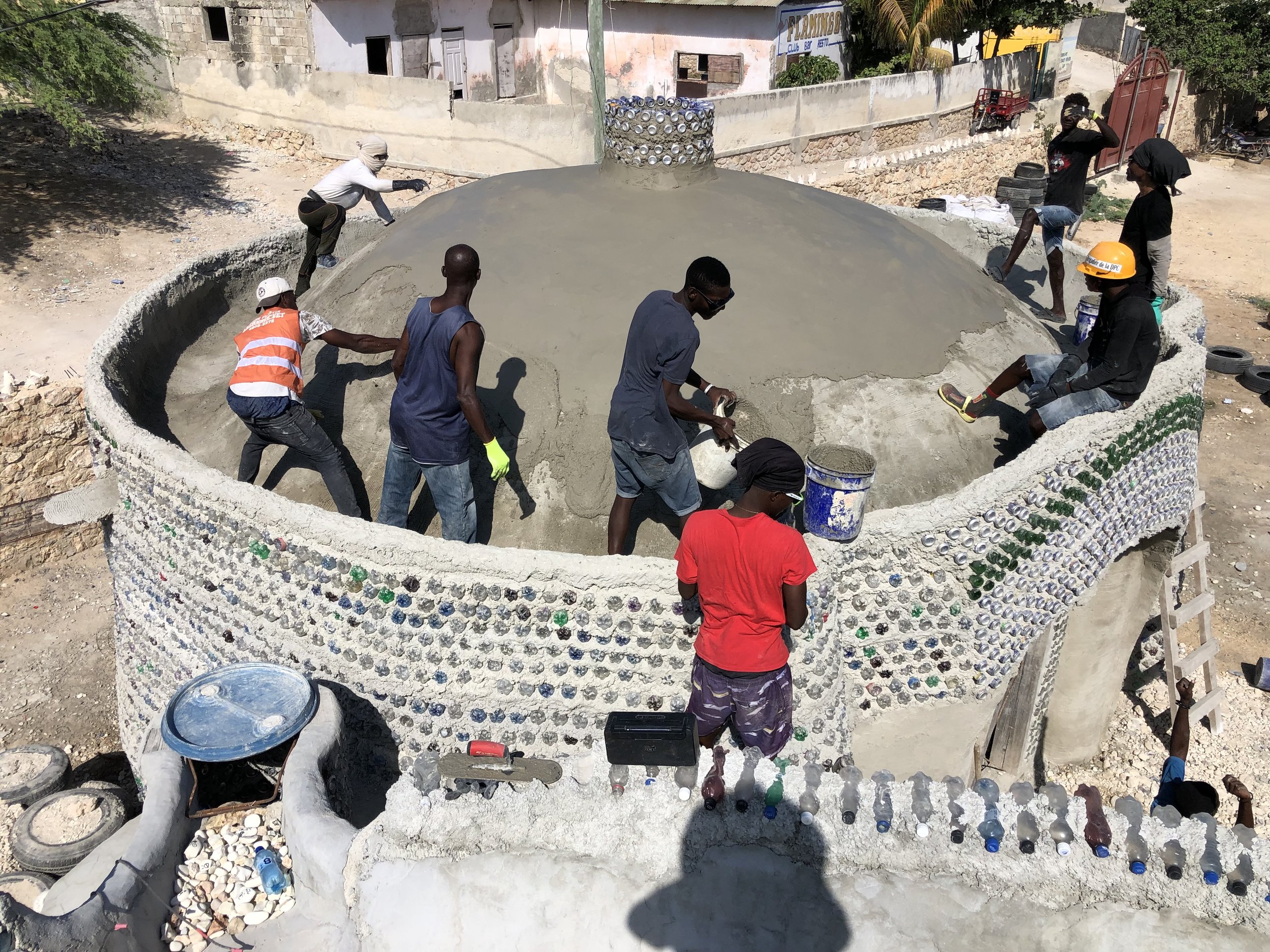HAITIAN SCHOOL PARTNERSHIP
The build in Anse a Galets, La Gonave, Haiti was started in November of 2020. The mission is to build six classrooms for an elementary school established by Greater Good Haiti in 2013. The school had been using an outdoor pavilion space and was in need of separate classrooms that could withstand hurricanes and earthquakes. As well as provide power, comfortable temperatures, and water in a place where all these basic needs are hard to come by.
There are currently 2 finished classrooms and a 3rd mid construction. There will be six in total on completion. This project was designed by Michael Reynolds.
The project was conceived and managed by the founders of ECOHAB in collaboration with Greater Good Haiti, Biotecture Planet Earth, and Earthship Biotecture. Greater Good Haiti and ECOHAB are now the sole partners in this effort. Each classroom is an 18' diameter circular structure of tires with a fero-cement dome. The mass walls and roof are insulated with up to 18" of crushed single use plastics. All building materials (which some call garbage) were collected within a couple miles of the site. We employ as many as 35 locals during each several week long build session. Time is taken in a classroom setting to educate the local crew, and the kids, on the concepts of the build and why it's appropriate to the location. The hands on work combined with classroom theory is a core approach of ECOHAB. The Haiti Eco Housing Project grew out of this education as several of the local crew became more accomplished in these building techniques, the housing project became a viable option to provide homes for themselves.
SITE LAYOUT
The school layout and classroom round hut design were chosen to help the building work with the natural disasters that frequently occur on the Island. The round structures allow movement during an earthquake and high winds to move freely around them. The deep wall structure keeps the classrooms cool during the hot afternoon sun. The dome roof’s are perfect for collecting rainwater.
The crew teaching the locals how to make bottle bricks. Used glass bottles are collected, cleaned, cut in half and taped together to create bricks that bring light and color into the space.
Empty rice bags are stuffed with rubbish to create roof insulation.
The bags are then encased in waterproof sheeting and plaster.
Garbage collected on the beaches of the Island is used to insulate each classroom. There is 15,000 gallons of rubbish, primarily single use plastics, in each building. The rubbish is placed in the wall cavity between the inner tire wall and the outer bottle wall. This helps keep the classroom cool all day long. The children collect the plastics as an exercise in alternative uses for it.
Galvanized steel tubes, usually used as part of our passive cooling system, are not available on the island so we built our own from rebar reinforced with remesh, plastered and buried in earth. The outside hot air is cooled as it travels through these underground tubes acting as a passive ‘air-conditioner’ for the classroom. As the air warms it rises, convection pulls it back out of the roof vent and allows cool air to take its place via these under ground cooling tubes.
The school children of Pi Gwo Byen enjoying their new classroom.
TESTIMONIAL
Phil Basehart has been the lead builder on our classroom construction project on the island of La Gonave, in Anse Galets, Haiti. Phil has demonstrated many outstanding attributes while facing the issues and logistical problems encountered while working in Haiti. Throughout this project I have come to know Phil as not only a builder, he is an environmentalist, humanitarian, teacher, and sage who demonstrates deep respect for people, place, and culture. We have been training a crew of builders under Phil’s guidance and it is clear to me that he warrants the deep respect that the crew holds for him, which, is in my view a profound mutual respect. Indeed I believe Phil meets all people in a place of mutual respect. His commitment to sustainability and best practices is commendable. Phil is dedicated to his vision of creating buildings in Haiti which are not only hurricane and earthquake resistant, using up-cycled materials; tires, bottles and trash, but are aesthetically meaningful as well as uniquely beautiful. His dedication to the process over product mindset is a fantastic example of how he transfers knowledge and skill to his students. He has pledged his commitment to our project and further work in Haiti and I am honored by his commitment, and look forward to a continued partnership of collaboration and community development.
- KELLY KOBZA, Founder of Greater Good Haiti























